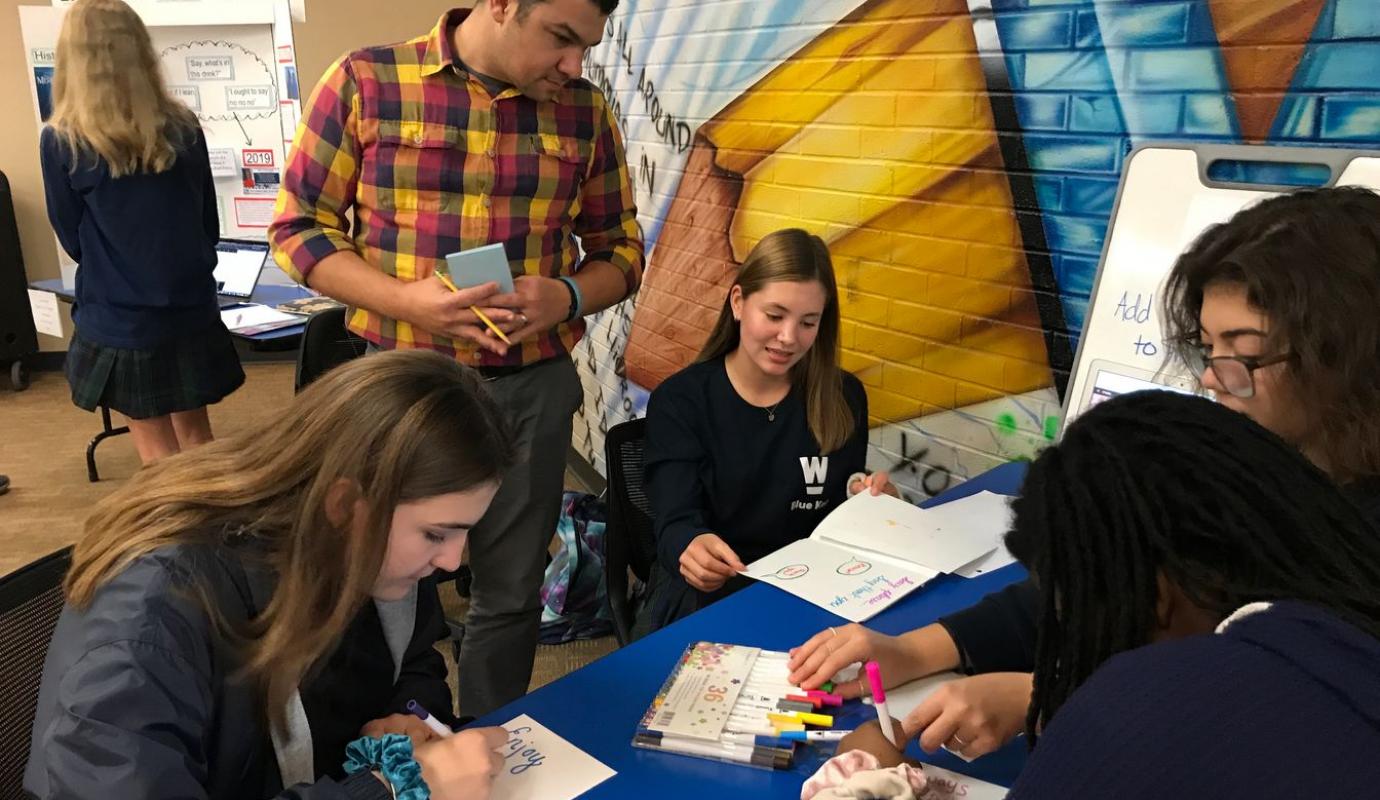The end of the first trimester in upper school means more than just an exam to ace, it’s an important moment for students to take on the role of expert and truly show what they know.
“Project Days provide opportunities to showcase student effort over a twelve week trimester,” Academic Dean Dr. Brandon Sullivan said. “These efforts are demonstrated over a broad range of assessment strategies including: cumulative exams, entrepreneurial sales pitches to local VCs, musical festivals, design challenges, to name just a few. Project Days give our students a means to move from consumers to producers of information.”
In Music and Literature, students examine the lyrics of some of their favorite songs through the lens of literary analysis. The course was designed by English teacher Drew Eberly out of a belief that the analysis skills traditionally used for literature can also be applied to music. One component of the class includes students selecting a song to research, write about its literary merit as well a cultural significance, and then create an immersive experience to share with the public. The songs they choose cross decades and genres for a fascinating exploration behind some of the most popular music of all time.
Historical context is vital to understanding the lyrics for songs like Billie Holiday’s haunting “Strange Fruit.” Senior Nick Robinson created a dark space called “The Bubble” in which visitors can completely focus on listening to the powerful meaning behind the lyrics. Other students invited members of the audience to engage in self-reflection. Mari Hannah ‘21 asked people to write positive messages about themselves to be placed on a mirror, eventually covering it completely, while listening to Kelsea Bellerini’s “Homecoming Queen.” A longtime fan of The Replacements, Mia Croft ‘20 equated the raw emotion conveyed in “Can’t Hardly Wait” with the creative process and provided paint supplies for listeners to unleash their inner artists. Check out more photos from Music and Literature on Vidigami.
In World at War, the class examines not just the events of the world wars but also the causes and consequences, including the civilian cost. For their final assessment, students designed memorials commemorating both World War I and II and present the thoughtful, informed reasoning behind their concepts. Ideas included immersive experiences that guided visitors chronologically through the darkness of the conflicts and then emerging on the side of light. Inspiration sometimes came from current monuments, like the reflective surface of the Vietnam Memorial that enables people to see themselves as no different from those directly involved in the war.
Heath Thomas ‘21 explained the goal of his “Price of Peace” memorial, to be placed in Belgium, is “to make visitors feel connected on a personal level.” Will Miller ‘21 used the symbolism of a lighthouse to convey a sense of warning as well as shed light on history in his “Lighthouse of the World” monument. Ryan Ray ‘20 wanted to emphasize the enormous civilian sacrifice as a result of war in his poignant rendering of loss. Check out more photos from World at War on Vidigami.
A deep sense of interconnectedness between humanity and environment informs other upper school courses like Environmental Art and Literature and Environment Eco Art. Teachers Keith Leonard P ‘33 and Jaime Bennati guide students on a journey of reflection about their own impact on the world through art, science, history, philosophy, and prose. They read the book “Pilgrim at Tinker Creek,” by Annie Dillard, and essays like Rachel Carlson’s “The Obligation to Endure,” John Muir’s “A Wind-Storm in the Forests,” as well as writing by Robin Wall Kimmerer, Terry Tempest Williams, Michael Pollan, and David Abrams, all in an effort to understand how American writers have historically related humans to nature and how they continue to influence people today.
For environmental art, the class studies artists who blur the lines between art and science. For their final project, “students were asked to create a site specific piece and choose the location around the school based off who might engage with the work, imagery chosen, and message conveyed,” Bennati shared. Topics such as consumerism, consumption, waste output, sustainable style, ocean pollution, and coral reef destruction, are all represented through mixed media pieces displayed throughout campus.
In her work, “Perspective,” Maya Hammond ‘20 covered a chair completely in plastic utensils to comment on consumerism and its impact on the ecosystem. “I ask that this be a reminder that even if we’re comfortable, there may be problems we can’t see,” Hammond wrote in her artistic statement. “After seeing this, try and take a second to look around and see how some choices could be good for you but bad for someone else. Please have a seat.”
Check out more photos from Environmental Art and Literature and Environment Eco Art on Vidigami.
